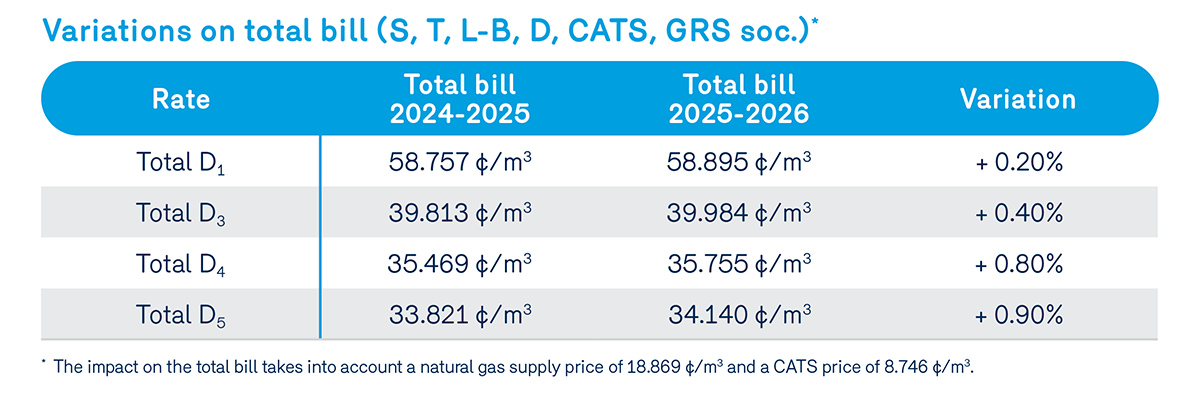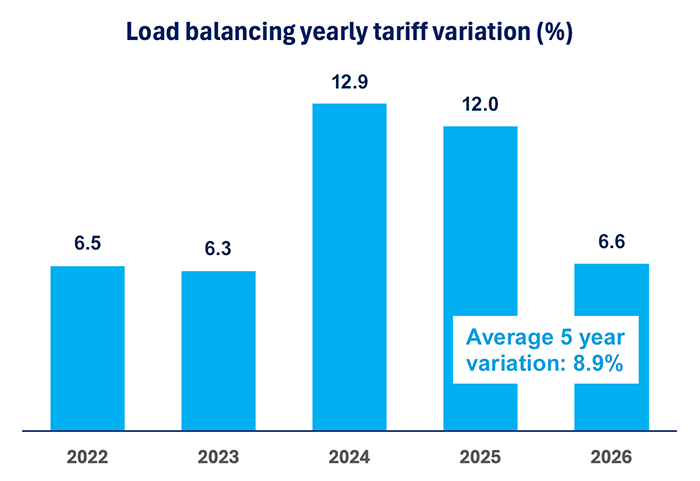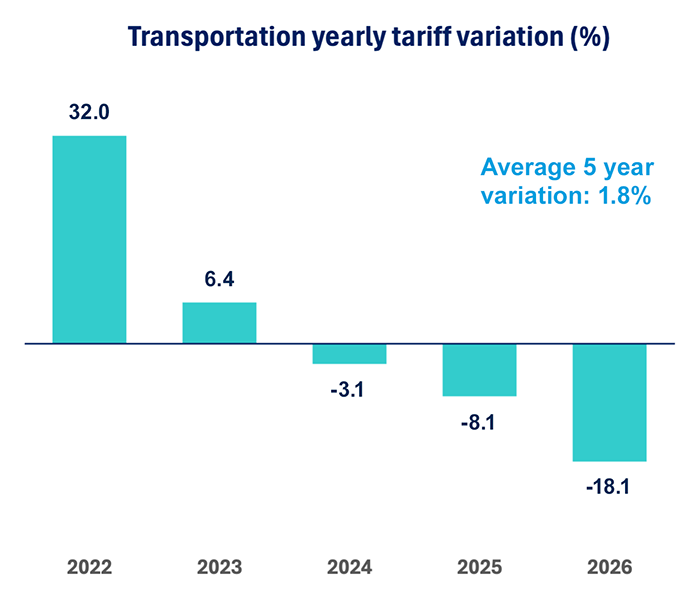Express Blue Bulletin
Major Industries
May 2025

New Rates for Fall 2025
Énergir’s proposed new rates were filed with the Régie de l’énergie on May 8 and are currently awaiting approval, with an intended application on October 1, 2025.
Learn more about our price changes in each section:
1. Price of Énergir's services
Overall, for all of Énergir’s services, the 2025–2026 rate case results in a rate increase of 1.15% or $12.6 million, broken down as follows:
- 2.15% decrease in distribution rates
- 18.10% decrease in transportation rates
- 6.61% increase in load-balancing rates
- 1.90% decrease in CATS inventory adjustments
- Increase in the GRS socialization fee following the increase in the target of GRS in the distribution system
Énergir’s distribution rates for 2025–2026 are down $16.0 million.
The main contributors to the decrease are as follows:
- Changes in net deferred expense account (DEA) balances relating to prior-year amounts to be returned to customers in connection with overpayments, revenue decoupling and budget variances related to future employee benefits (-$26.4 million)
Partially offset by:
- The change in the net DEA balance relating to temperature and wind rate stabilization (+$10.5 million)
- A warmer than average winter in 2024 and 2025 resulting in lower than expected revenue
What is a deferred expense account (DEA)?
A DEA is a regulatory tool used to calculate incurred fees that will be deferred to a later date.
Depending on the situation, deferred fees may be remitted or recovered from customers. If there are fees to be recovered, there will be a rate increase. If there are fees to be remitted, there will be a rate decrease. There are a number of reasons for using DEAs. The most common is the determination of actual results at the end of the year that prove to be higher or lower than anticipated in the rate case. The resulting difference is then incorporated into a subsequent year’s rates.
The rate decrease for transportation (-$30.2 million) is largely attributable to:
- Lower transportation costs, due mainly to the change in the location differential on natural gas purchases from Empress versus Dawn, resulting in a decrease of $23.3 million
- The $9.2 million decrease in depreciation from the overpayment in fiscal year 2023–2024 and the end of the shortfall recovery for fiscal year 2020–2021
Partially offset by:
- The $3.3 million decrease in transportation revenue due to lower distributed volumes
The $10.9 million increase in the load-balancing rate is mainly due to:
- The $7.7 million increase in load-balancing costs, mainly due to the decrease in exchange transactions leading to optimization revenues and higher storage costs, offset by the change in the location differential on natural gas purchases from Empress resulting from a functionalized balancing credit
- The increase in depreciation ($2.9 million) due to the higher shortfall in fiscal year 2023–2024 than in fiscal year 2020–2021
Overall, the rate change for transportation, load-balancing and distribution services totalled -3.3%. The details by service are shown in the table below.
| Service | Variation in Rates |
| Transportation | -18,1% |
| Load balancing | +6,6% |
| Distribution | -2,15% |
The table below shows the average variation on a bill attributable to the three services mentioned, for each distribution rate.

For variations in transportation (T), load-balancing (L), CATS maintenance adjustments (I) and distribution (D) services for each rate level, refer to the comprehensive table .
After four years of distribution rate increases, a reduction is proposed for 2025–2026. Additionally, transportation costs continue to be adjusted downward, helping to offset an increase in load-balancing costs.



As indicated in its 2024 Annual Report, Énergir met the target of 2% GRS in its distribution system as required by the Regulation respecting the quantity of gas from renewable sources to be delivered by a distributor. Concretely, this represented 124 Mm3 of GRS, broken down as follows:
- 34 Mm3 of voluntary purchases by customers
- 90 Mm3 of socialized volumes
The costs associated with these socialized volumes will be recovered by October 1, 2025, on all the volumes consumed by customers over a period of one year.
What is the rate for the GRS socialization fee?
The rate for GRS socialization fee is 0.960¢/m3 for the 2025–2026 rate case. The socialization fee should represent 2.1% of an average customer’s total invoice.
Customers exempt from the GRS socialization fee rate
Customers whose GRS consumption exceeds the objective of the government regulation are not subject to the GRS socialization fee rate.
2. Price of Gas from Renewable Sources (GRS)
In its 2025–2026 rate case, Énergir filed the proposed price for GRS and is currently awaiting approval to implement it as of October 1, 2025. The price of GRS will increase from $22.65/GJ (85.818¢/m³) to $25.04/GJ (94.884¢/m³).
The GRS supply rate represents the average acquisition cost of projected purchases for the next 12 months. The increase in the average purchase price is due to increasing GRS prices and the fact that Énergir must buy more GRS to meet its regulatory GRS injection obligations. Initiatives are underway to stabilize or reduce the price of GRS.